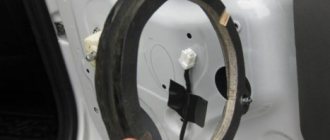Lada Vesta is the most popular passenger car in Russia at the end of last year. The new Lada Vesta was purchased 108,364 times in 2020, which is 40% more than in 2020, in which it was sold 77,291 times. Kia Rio dropped from first place to third in the list of best-selling new passenger vehicles in the Russian Federation for 2018, behind Hyundai Solaris. The results for the Kia Rio are as follows: 100,148 units were purchased in 2020 and 96,689 units. — in 2020, i.e. sales growth was only 4%. Let's compare these two sedans and try to understand whether the Korean model can again become a sales leader in 2020.
Body dimensions
Let's start comparing Lada Vesta and Kia Rio with the features and dimensions of the body. The domestic manufacturer currently offers its model only in sedan design. The Koreans also produce a hatchback. In the near future, the Russians are planning to expand the line, so we just have to wait a little.
Below are the dimensions of Lada Vesta / Kia Rio:
- length (m) – 4.41 / 4.37;
- height (m) – 1.49 / 1.47;
- width – 1.76 / 1.7;
- ground clearance (cm) – 17.8 / 16.0;
- luggage compartment capacity (l) – 480 / 470;
- weight (t) – 1.23 / 1.055;
- wheelbase (m) – 2.63 / 2.57.
Comparison of appearance and exterior of Lada Vesta and Kia Rio
Comparing designs is a very subjective opinion, so it won’t be possible to say objectively which is better in this case. Both cars look modern and stylish. Kia Rio was created with an emphasis on a young audience, as evidenced by almost all design decisions - a “tiger nose” style radiator grille with chrome trim, squinted aggressive headlights, boomerang-shaped fog lights. The roof of the car is tilted slightly back, and the profile of the car itself is tilted forward. And the large rear lights, which by the way fit perfectly into the design of the car, complement the overall picture and make the car even more attractive.
Lada Vesta with its X-design is in no way inferior to Kia Rio. However, the sporty attitude here borders and coexists perfectly with aggressiveness. Although all the curves and smooth lines create the impression of a modern classic sedan. This car setup is suitable for buyers of absolutely any age.
Let's compare the dimensions and ground clearance of both cars. For clarity, let's look at the diagram:
Having compared all the sizes, we can conclude that the Lada Vesta, although slightly, is larger than the Kia Rio. Regarding ground clearance, Lada Vesta also beats Kia Rio. And for Russian roads this is a very, very important advantage.
Appearance
It is not so easy to determine which is better - Lada Vesta or Kia Rio in terms of exterior. Both cars have a stylish appearance, but the conceptual approaches to its creation turned out to be different. The Korean car was created with an emphasis on the youth audience, which determined the design. It has a mass of flowing lines, the radiator grille resembles the nose of a tiger. Additional charm is given by narrow, elongated optics, an air intake with chrome inserts and original fog lights.
The Kia profile leans slightly forward, the sidewalls are equipped with impressive stamped elements, and the picture is complemented by chrome trim around the window openings. The stern with large light elements flows harmoniously into the roof, which is slightly tilted back. In general, everything is tasteful and quite dynamic, which attracts young people.
Vesta is not particularly inferior to its competitor, however, sophistication here is replaced by aggressiveness. The headlights have a classic configuration, the radiator grille and air intake are arranged together. Chrome lines add modernity to the sedan. The appearance will appeal to both young people and older drivers.
The impressiveness of the profile is due to the presence of X-shaped features of the panels and original rims. The rear part is also designed at a high level, the straight lines of the headlights look great against the background of the chrome LADA logo.
Comparative test drive
Kia Rio and Hyundai Solaris engines For a more objective test, the Vesta with the most powerful engine (114 hp) should have been placed next to the Koreans, but a simpler configuration with a power unit of 106 hp was available.
The gearboxes are also different. Lada Vesta is equipped with an AMT (automatic five-speed gearbox). Foreign cars have automatic transmission (six-speed torque converter). These units operate more logically and smoothly than the VAZ transmission. Compared to the automatic transmission, the “robot” performed poorly when accelerating on the move. In such a situation, the box is late in downshifting, but in this case the manual mode saves. But compared to other “robots,” for example, French ones, Lada Vesta drives more carefully, and gear shifts occur in a timely manner and quite smoothly.
But another fact is truly frightening. The pilot of the auto magazine noted that the automated gearbox of the Lada Vesta “howls” under load. This problem has been familiar to us for a long time; it causes a lot of dissatisfaction among owners of modern Lada cars. We recommend that future Vesta owners consider configurations with a French manual transmission.
suspension handles every bump in the road quite harshly, while the Lada Vesta simply doesn’t notice all these little things. The result is a smoother, more refined ride. This is thanks to the new suspension, which is no longer similar to the one that was used previously. And if you install wheels with higher tires instead of R16, then the domestic car becomes unrivaled.
The steering of the Solaris and Rio is sharper; the Koreans take turns more fun due to the denser suspension, which allows for a minimum of roll. The Lada Vesta rolls more, but everything is within normal limits. But the steering wheel is much more informative.
the brakes of foreign cars better. On the Vesta, the pedal seemed too long-travel; it was a little more difficult to control the deceleration than in the Rio and Solaris. But this is a matter of habit.
| Equipment\Vehicle | Price Lada Vesta | Cost of Kia Rio | Price of Hyundai Solaris |
| Basic (simplest) version | 514,000 rubles | 549,900 rubles | 535,900 rubles |
| Average equipment | 580,000 rubles | 630-690 thousand rubles | 620-660 thousand rubles |
| Maximum package "Lux" | 677,000 rubles | 809,900 rubles | 715,400 rubles |
Summing up, we can confidently say that Lada Vesta is a full-fledged player in the modern car market, capable of taking away a significant share of buyers from the leaders. The only thing that can prevent you from becoming a bestseller is the high price. But compared to the Koreans, she doesn’t seem like that!
Let us remind you that you can study the Lada Vesta in more detail from the reviews or testimonials category.
1
0
Found an error? Select it and press Ctrl+Enter..
- Discounts and promotions for the purchase of LADA in September 2020
- An example of tuning a Lada Vesta SW Cross in the studio
- Electrical diagrams Lada XRAY
- CityGuide firmware for Lada Vesta (user-friendly interface, cameras, ambushes)
Standard power units
If you compare the new Kia Rio or Lada Vesta in terms of engines, the Korean is definitely the winner. The car line includes high-quality engines of several modifications. Kia offers buyers two 16-valve options. The first of them has a volume of 1.4 liters and produces up to 107 “horses” with a torque of 135 Nm. The car accelerates to hundreds in 11.5 seconds, and the maximum speed is 190 km/h.
A domestic car is equipped with a 106 hp engine. With. The acceleration speed is slightly faster than the competitor (11.8 seconds). The remaining parameters are also almost identical, except for fuel consumption. This figure for a Korean car in the city is about 7.8 liters per 100 km, while for its Russian counterpart it reaches 9.3 liters.
Specifications
So far, the KIA Rio has an advantage in this regard, since the Korean model is able to offer the buyer a pair of power units, while the Vesta, which has three engines in a cage, is currently sold with only one. Both cars have common features in terms of the engine range - all engines are naturally aspirated, with an injection power system; there are no turbocharged units, as well as diesel engines, in the range.
Video: LADA VESTA // Part 2: in service. Vesta on a lift
The first Rio engine is a standard 16-valve engine with a volume of 1.4 liters. Despite its modest cubic capacity, it produces 107 hp. With. power at 6,300 rpm. And its traction is not bad - 135 Nm of torque at 5,000 rpm. Rio is not particularly fast with it, accelerating to hundreds in 11.5 seconds, but it can boast a top speed of 190 km/h. And all this with a consumption of 7.6 liters in city conditions. In addition, the Rio engine runs on 92 gasoline.
The 1.6-liter engine of the Korean sedan is noticeably more powerful. Its output is already 123 horses at the same 6,300 rpm. But the thrust not only became somewhat greater, adding 20 “newtons” (up to 155 Nm of torque), but its peak was also lower – 4,200 rpm. Acceleration with it is noticeably faster and takes 10.3 seconds. However, the change in characteristics did not affect the maximum speed - still the same 190 km/h. Consumption has increased, but not too significantly - up to 8.5 liters per hundred square meters (also AI-92).
So far, the Lada Vesta can only oppose the Korean with a Russian 16-valve VAZ-21127 type, with a volume of 1.6 liters. At 5,800 rpm it produces 106 horses, with 148 Nm of torque at 4,200 rpm. However, the advantage in the form of a lower peak power and torque in terms of dynamics does not give superiority even over the 1.4-liter Rio engine - 11.8 seconds. up to a hundred. This also applies to the maximum speed, which is limited to 178 km/h. And his appetite is higher - it reaches almost 10 liters in the city, and the AI-95 engine consumes it.
Another Vesta engine, the budget VAZ-21116, is a 1.6-liter 8-valve engine with a capacity of 87 horses. And the top one will be the 1.6-liter HR16DE-H4M engine, proposed by Alliance Renault Nissan, derated to 114 horses. But the exact characteristics of Vesta with them are still unknown. In addition, there is information about the development of a 1.8-liter VAZ-21179 engine. But it will not appear under the hood of Vesta before the fall of 2020.
Therefore, in terms of power units, the KIA Rio has a noticeable advantage, for now...
In terms of transmissions, the Rio wins. Despite the fact that the cars have 2 transmission options, Rio has two manual transmissions and a pair of automatic transmissions. The companies' approaches to equipment vary. The Korean company took the classic route, offering fans a manual transmission in 2 versions (5 and 6 gears), as well as a pair of automatic transmissions (4- and 6-speed). Moreover, 6-speed gearboxes are available only for versions with a 123-horsepower engine.
Video: Lada VESTA vs KIA Rio.
AvtoVAZ took a different path. Vesta has only one manual transmission – a 5-speed, but there is no automatic transmission. Instead, there is a 5-band robotic transmission, which the Russian automaker preferred for the sake of greater savings. In addition, Tolyatti plans to install a continuously variable variator on Vesta.
In general, manual transmissions are equal - they turn on clearly, the lever does not fly out of the grooves, the force on it is adjusted (although not the standard), the strokes are quite short, and the gear ratios are chosen well. However, the presence of a 6-speed transmission in Rio allows it to be noticeably more economical, which is doubly valuable, since the top-end engine is significantly more powerful than the VAZ engine. But buyers and potential clients have different opinions about the robot - some think it is a very worthy unit, while others kick it for twitching in traffic jams. Of course, there are slight jolts when switching, but they are quite tolerable. The same 4-band automatic transmission in Rio is no better. But it’s hard for Vesta to compete with the top-end automatic transmission of the Korean sedan (6 gears).
Lada Vesta interior
The chassis design of the car is the same. They have MacPherson struts at the front, and a semi-independent design (torsion beam) is mounted at the rear. The Lada chassis is tuned to unexpectedly high quality. In motion, it is almost as good as Rio, and if you consider that Vesta’s ground clearance is 18 mm higher, which implies a different location of the center of gravity, then the result of the Russian car can be considered excellent. Vesta's driving qualities are at the level of competitors - clear and precise reactions to steering turns, slight sway at high speed, body roll that does not annoy the owner, etc. In addition, the chassis performs well outside the asphalt - long shock absorber strokes, softness, energy consumption and other trump cards appear in all their glory.
The Rio's chassis is preferable on asphalt - the sharpness of the steering is a little better, as is the performance of the brakes, and the tightness of the suspension is pleasing. But on a primer or broken surface, the KIA Rio is completely inferior to the domestic sedan - the struts more often work to break down, and all the irregularities are transferred internally.
Other engines
Continuing to compare the Lada Vesta and the Kia Rio, it can be noted that the Rio Vesta cannot yet compete with the 1.6-liter engine. Engineers from Korea achieved excellent results, squeezing out 123 horsepower on a standard naturally aspirated engine. At the same time, the traction indicator increased to 155 Nm, the dynamics of the car increased (10.3 seconds to 100 km), the maximum speed remained at the same level.
Domestic designers cannot boast of such successes, but they have already begun to install a 1.8 liter engine with a power of 122 hp on the X-Ray version. With. It is expected that with it the Russian car will become more dynamic and create real competition with its Korean counterparts. The plans include a derated engine to 110 hp. With. French HR16DE engine and a lightweight eight-valve unit producing 87 hp. s, designed to reduce the cost of the vehicle.
How much does maintenance cost?
For many car enthusiasts, the question of the cost of “consumables” for maintenance is of interest. The topic is important because the warranty is canceled due to failure to comply with maintenance deadlines, which is prudently stipulated in the contract of any dealer. The inspection interval for both vehicles is 15,000 km or 1 year, whichever comes first.
Which car will cost less in terms of maintaining it in good condition - Lada Vesta or Kia Rio and what is better offered by dealerships until the mileage reaches 120,000 km? To make it more convenient to calculate, let’s consider the average price of materials and the cost of standard hours at dealers, for which we will use cars with manual transmission and naturally aspirated 1.6 liter engines with a capacity of 106 hp for Vesta and 123 hp. at Rio.
Transmission unit
Next in the comparison of Kia Rio and Lada Vesta is the transmission. Each model has several transmission options. The Russian car has a couple of mechanical kits in stock. One of them was created by VAZ specialists, the second was borrowed from French manufacturers (JH3-510). Both boxes have five modes and multi-body synchronizers. The Russian version from Priora has been radically redesigned. A number of foreign parts were introduced into the unit, the secondary shaft was strengthened, which made it possible to achieve a reduction in the lever stroke and clear gear shifting.
Kia Rio has a pair of manual transmissions (for 5 and 6 ranges). In the second case, highway driving is noticeably improved due to reduced fuel consumption. At the same time, the gears are short, and in the city they manifest themselves at increased engine speeds.
Comparing car interiors
Landing. The height of the test driver of the auto magazine was about 2 meters and when landing in both foreign cars he fit quite tolerably. There were comments about the short seat cushion, which resulted in the knees being bent a little more than we would like. It will be noticeably more comfortable for a shorter person. There was more space in the Lada Vesta, the seat is comfortable, but only the “Comfort” and “Lux” trim levels have height adjustment.
Multimedia system (MMS) . The radios of the Kia Rio and Hyundai Solaris are the same, the only difference is the backlight. In the first case it is red, while in Hyundai it is poisonous blue. The MMC functionality of all three cars is similar, there is Bluetooth and a USB connector. Vesta has a slot for SD cards, while its rivals do not.
The sound quality of the Lada Vesta radio is clearly more interesting! The editor notes the presence of bass and clear highs. The middle is a little full, but there is volume. At medium volume, the sound should satisfy even the pickiest. Rio has a good volume reserve. And in Solaris, even at medium volume, the rattling of the door trims was heard.
legroom in the rear seats in Vesta than in Rio and Solaris, this is the only plus. The head rests on the ceiling even for a short person, and the back of the rear sofa is lower.
The volume of luggage compartments is as follows: first place Rio - 500 liters, Vesta - 480 liters, and Solaris - 465 liters. It is worth noting that only domestic cars do not have a trunk opening button under the license plate, like the Koreans. You can open the trunk of the Vesta only with a button from the interior or with a key.
More about the shortcomings of the Lada Vesta . We turn off the engine and remove the ignition key, the stove continues to work. You have to turn off the fan manually. The situation is similar with headlights. However, in the maximum configuration of the car, the devices turn off independently. It is also worth noting the flimsy and dangling air flow regulators of the ventilation system. The good news is that even with standard equipment, the steering wheel can be adjusted to suit you both in height and reach. But you will have to look for the steering column adjustment lock. Once you can find it, you will have to try hard to pry it off. On the other hand, you won’t have to use this adjustment often.
Automatic transmission
We will continue the description of the Lada Vesta by studying the automatic transmission. It is a robotic unit with an AMT configuration with five operating modes. A “robot” is cheaper to produce than an “automatic machine,” which was the determining factor in favor of its choice. In general, the unit does not cause any complaints; shifting ranges is still more noticeable than in a classic automatic transmission.
They offer two options for standard automatic transmissions – 4- and 6-speed. The first modification has no particularly outstanding qualities; it is quite suitable for leisurely city driving. The second version of the automatic transmission is distinguished by clear shifts, efficiency, and absence of jerks.
Car boxes
The different trim levels of both cars offer a choice of manual or automatic transmissions. Kia Rio buyers receive a car with a 5 or 6 speed manual transmission or a classic automatic transmission with 4 and 6 speeds. The Kia manual transmission allows the driver to shift gears smoothly but clearly. Motorists who often travel on highways will prefer the 6-speed version, it significantly saves fuel. For city driving, 5 manual gears are enough.
The 6-range automatic on the Kia Rio is unique and has no competitors. On the highway, it switches gears as clearly as possible, without jerking, without consuming a large amount of vehicle resources. The 4-band option is acceptable for frequent city driving, but has some disadvantages.
The Lada Vesta gearbox is produced in two mechanical and one automatic versions. Both manual transmissions are 5 speed. They differ by manufacturer. One was taken from Priora, carefully reworked by Russian specialists, the other was adopted from French colleagues. True, for 2020 only the Russian box is installed on Vesta. Modern imported materials have made it possible to make the box worthy of competition with foreign cars.
The Lada vesta automatic transmission is not a classic automatic transmission, but a 5-speed robotic version. It behaves decently on the road, but still loses to the automatic transmissions of the Kia Rio.
Chassis
The chassis of one and the other car is identical in design. The front part is equipped with MacPherson struts, and torsion beams are provided at the rear. Handling quality is also almost identical. The sedan from Russia has a higher suspension energy intensity parameter. If you add here the increased ground clearance, the ride becomes more confident.
The Korean model handles comfortably, except for wobbling at speeds over 140 km/h. This behavior forces the driver to constantly steer, which is exhausting during long journeys. In other cases - complete order.
What about transmissions?
Lada Vesta uses two five-speed manual transmissions: domestic (VAZ-2180) and French (JH3 510). The basis of the Russian manual transmission is taken from Priora and significantly redesigned with foreign components. Instead of an automatic transmission, Vesta uses a 5-band AMT (robot), which has lower operating and repair costs.
Gearbox Lada Vesta and Kia Rio Kia Rio is equipped with two manual and two automatic gearboxes. The first “mechanics” has 5 stages, the second – six. The Korean transmission works clearly and smoothly. “Korean” “automatic machines” have 4 ranges and 6, respectively. In this aspect, Kia Rio has practically no competitors.
What's in the cabin?
It would also be useful to compare the Lada-Vesta (sedan) with the Kia-Rio in terms of the interior. The maximum similarity of the interiors of both vehicles is striking. Many note that the designers of the domestic car plant appreciated the design of the Korean, adopting many elements.
Among the common features:
- dashboard;
- three-spoke steering wheel;
- center console;
- good ergonomics and visibility;
- Quite high quality finishing materials (for its class).
Thanks to the increased dimensions, there is more space in the interior of a domestic car.
Options
- The Kia Rio comes standard with a good audio system, electric windows on the front windows, heated mirrors and two airbags. The maximum configuration of the Korean has climate control, a more powerful music system, power windows on all windows, keyless access, a heated steering wheel, and additional airbags. For the Kia Rio, the maximum configuration is available with larger wheels - 16 instead of 15.
- The Lada Vesta's equipment in key points is similar to the Kia Rio. More expensive versions of the car are also sold with 16 wheels, and the basic version has 15 inches. The starting version is immediately equipped with ABS and exchange rate stability system.
Equipment and prices
Kia Rio, like Lada Vesta, offers consumers many trim levels (6 and 7, respectively). The Russian car is preferable in this regard, as it can accommodate decent stuffing at a much lower price. This is especially true for basic configurations. The price ranges from 520 to 815 thousand rubles.
The configurations and prices of the Kia Rio are interconnected. However, the difference between a Russian car and a Korean one with the same equipment is approximately 80-200, which is not so little. It is worth noting that the Korean 1.4-liter model does not have top-end versions at all.
As a result, a significant difference in cost is due to the presence of a more powerful engine, automatic transmission and better finishing elements. Since the configurations are almost equal, we can conclude that the significant overpayment is due to the popularity of the brand.
Lada Vesta, Ford Fiesta, Kia Rio, Renault Logan or Volkswagen Polo - which is better?
We thought that the Ford Fiesta would become a newsmaker. We gathered obvious competitors, arrived at the training ground... And here it began! How, by hook or by crook, we first got a camouflaged Vesta, and then another one, in all its glory, is the topic of a separate adventure story. As a result, there are four sworn competitors and an ambitious newcomer who will probably cut off some of the buyers from each. All with 1.6 engines, all with “mechanics” - and all assembled in Russia. Ford Fiesta, Kia Rio, Renault Logan, Volkswagen Polo and Lada Vesta.
I've driven a Vesta before - in Spain and in Sochi - but those camouflaged cars were very far from “marketable”, and the interior couldn’t even be called a salon. So, the test driver’s workplace. Now it's a different matter! The steering wheel has a grippy shagreen rim, well-fitting panels, and the texture of the plastic is at least no worse than that of Renault or Kia. But Volkswagen and Ford delight with a more comfortable interior. Fiesta is generally the only car in this budget segment that pampers with a soft, pleasant not only to the eye, but also to the touch front panel finish. However, the Fiesta, although nice inside, is a bit cramped: the front seats are close to each other. And the seats themselves are simple and molded for slender drivers, although the range of adjustments is sufficient even for those who are 190 cm tall. I was unpleasantly surprised by the un-Ford-like loose gear shift lever: in working positions the play is unreasonably large. It was also not easy for me to find a common language with Ford’s multimedia system: the functional load of the “hot” buttons changes depending on the selected mode, and data has to be read from a small display overloaded with information.
Vesta was most surprised by her driving manners: stable in a straight line, adventurous and at the same time safe in turns. And it’s good on rough roads: the suspension is impenetrable, and the ground clearance will be the envy of other crossovers
Vesta looks fresh, but sometimes the characteristic X-stampings seem deliberately Asian, and the gas filler flap is inappropriately rough from any angle and lighting
0 / 0
Vesta's interior is noticeably more spacious, the driver's seat pleases with an unobtrusive and at the same time acceptable profile for drivers of different sizes. The instruments recessed into three wells are rustic; glare dances on the glass, making it difficult to perceive information. But at night, the devices are transformed: the “lunar” backlight pleasantly “spreads” from the central rings, matching all the luminous symbols. The font, however, is not the best, including on the information display. But by clicking the button at the end of the right steering column switch, you can display on the screen not only the values of fuel consumption, average speed or power reserve, but also the voltage in the on-board network, which you cannot “interrogate” from competing cars. Maybe the VAZ people are worried about the reliability of the generator and are playing it safe - remember what a problem the Grants had at first, when during our life tests we changed one generator after another?
Vesta's interior is more interesting than in other foreign cars: the steering wheel is pleasant to the touch and adjustable in height and reach, the plastic of the front panel is hard, but of good quality. However, the “music” and microclimate settings buttons do not please with the same precise movements as in Rio or Polo
The front seats with sufficient adjustment ranges perfectly distribute the load, and starting from the “middle” Comfort configuration, both height adjustment and lumbar support are available
This is what the center console looks like in the Comfort package. More expensive versions offer a multimedia system with a seven-inch touch screen and climate control
0 / 0
The font chosen for digitizing instruments is not the best: on a sunny day, glare on the plastic walls of the wells and glass interferes, and secondary information at the bottom is presented in too small characters. But in the dark you can admire the “moonlight” illumination
The font chosen for digitizing instruments is not the best: on a sunny day, glare on the plastic walls of the wells and glass interferes, and secondary information at the bottom is presented in too small characters. But in the dark you can admire the “moonlight” illumination
0 / 0
Vesta's multimedia system will be available in two, or rather, even three formats, if you count the plastic plug on the center console and the audio setup of four speakers as such. In the second, like on our car, it’s a radio with a small monochrome screen and large ones - you can’t miss it! - control buttons. And in the third there is a seven-inch touch panel familiar from Grants and Kalinas, which, in addition to a lot of expected functions, will soon be able to transmit images from the rear view camera and even draw a trajectory. Of the four competitors, only Renault Logan and Ford Fiesta can be equipped with standard navigation, and rear view cameras are not available for any of the cars.
The SOS button of the ERA-GLONASS system is already working - and about who needs it and why, read here
At the base of the center console there is a 12-volt socket, a USB connector and, albeit small, a niche covered with a rubber mat.
The glove compartment is large, cooled by air conditioning. But there are no niches or shelves, and the plastic is without embossing. Inappropriate "budget" impression
The trunk is unlocked with a button from inside the cabin, remotely from the key fob, or with the key itself. And although a button on the lid would be best suited for this purpose, it is not there. But they promise that it will be
0 / 0
And yet, when you change from Vesta to Rio or Polo, you realize that it’s more comfortable here. The Rio instruments are beautiful and clear, and the gear selector lever is nicer too. In Polo, the instruments are simpler and stricter, but the seat is impeccable, all the handles and buttons delight with verified “premium” efforts, and the lever works perfectly. True, the clutch pedal travel is too long, and it itself is slightly shifted to the right
The full version is available only to subscribersSubscribe now
I'm already subscribed
Test drive Kia Rio and Lada Vesta
Getting in and out of the steering column is convenient in both cars. The only thing is that the “Korean” has to make more effort to slam the door. A comfortable position in the driver's seat is ensured by height and reach adjustments, plus the ability to adjust the position of the seat in three positions.
The instrument panel is easy to read for both representatives; it is not possible to mark one of them with anything. The on-board computer panel of the Korean car is more informative, but the glove compartment is more spacious in the Russian sedan. In addition, it is equipped with backlight.
As for the road, it is preferable to take turns and take turns in a Lada. The car behaves faster and more collectedly on curved sections of the road. In addition, the suspension confidently and reliably handles all the troubles inherent in Russian roads. “Kia” is a more fastidious option, it behaves well on flat sections, is not afraid of ruts, and takes corners well. But bumps, potholes or speed bumps must be passed at minimum speed.
Another significant drawback was noticed during testing of the Rio - noise. At high speeds, the cabin is filled with a level of noise that creates the feeling of driving in a convertible without a roof, not to mention if a powerful truck is passing next door. The luggage compartments of both sedans are identical in capacity, with full-size spare tires and tool kits placed in the subfloors. The rear seatbacks recline in a 60/40 ratio, and the trunk lid can only be opened from the interior or with the key.
Salon
The interior design of the Vesta modification SV Cross looks quite stylish. Against this background, Rio doesn't look so good - its interior is downright boring.
Compared to the Lada, the Kia car is more comfortable. Its seats perfectly support the backs of passengers, the only problem is that the seats themselves are a bit short, although they are quite soft. In Vesta, on the contrary, they are excessively rigid, but on the other hand, passengers on the rear sofa are given noticeably more space.
Kia Rio and SV Cross have a common drawback - a low ceiling. Therefore, if a tall person can straighten up, he will cling to the roof with the top of his head.
The good quality of the Kia's interior trim and equipment gives it an edge. Vesta has a lot of disadvantages:
- harsh steering wheel;
- tight buttons;
- Difficult to read instrument dials.
At the same time, the SV Cross steering wheel is easily adjustable both in height and reach. The Korean has more limited functionality.
Vesta has more seat upholstery options. With an overall black color, gray or orange inserts are offered. Here the comparison result is disappointing for Kia - the black tint is diluted only by red. The quality of textiles on the Lada is lower than on its Korean competitor.
conclusions
From the point of view of the development of the Russian automobile industry, Cross can be considered a definite breakthrough. The station wagon model is not very popular in Russia yet, but has great potential.
The Kia Rio X Line is superior to the Russian Cross due to its high profile tires and automatic transmission. But the AVTOVAZ model has greater cross-country ability due to its ground clearance, and will also attract consumers with a spacious interior and ergonomic trunk.
Comparing prices and configurations, it can be argued that the Cross is more economical than the Korean. But, looking into the future, we also need to evaluate maintenance and the warranty period, which the Korean has longer.
Body paintwork and metal thickness
Paintwork is the most important element of external protection for a car. The thickness of the paintwork, measured in neurons, is an indicator of quality. In different models of foreign cars, the spread of coating thickness ranges from 80 to 180 microns, and it varies in different parts of the car.
Lada vesta sw cross and the kia rio x line model have paintwork indicators of 120–135 and 138–173 microns. Russian new product Cross, available in 10 shades. For example, the spectacular bright scarlet metallic Mars. In the near future, the manufacturer intends to expand the color line.
The Korean Rio comes in 9 paint options, and the color scheme is bolder and includes, in addition to neutrals, Marina Blue and Sunset Orange. The Lada Vesta Cross, like the Kia Rio x Line in the new body, deserves all sorts of praise for the quality of the paintwork. Even places that are difficult from the point of view of the craftsmen - arches, internal compartments, bevels of doorways - are painted neatly and evenly. The relief of the paintwork (which is usually called shagreen), then it differs on plastic and metal parts. This is explained by painting technology.











